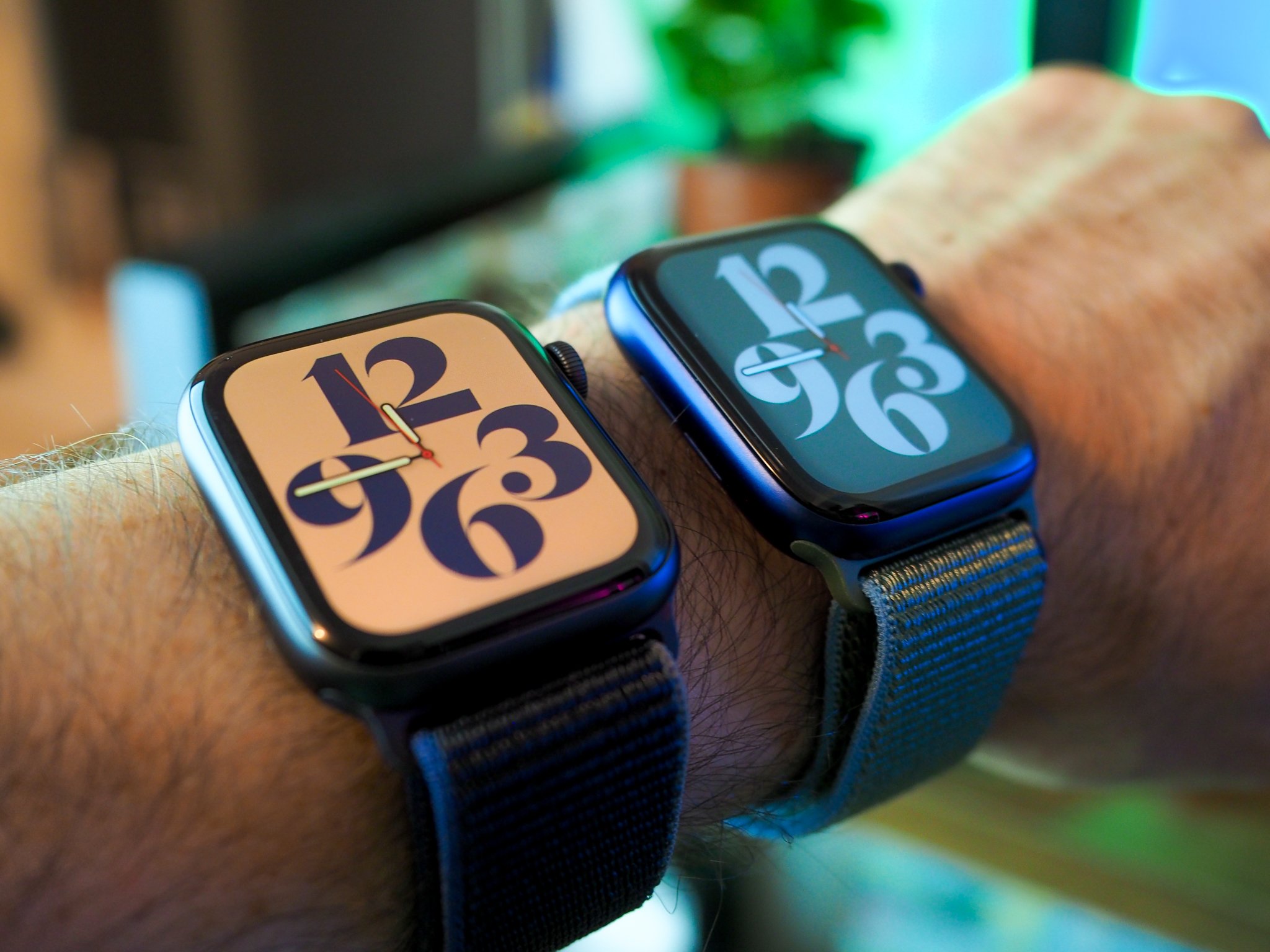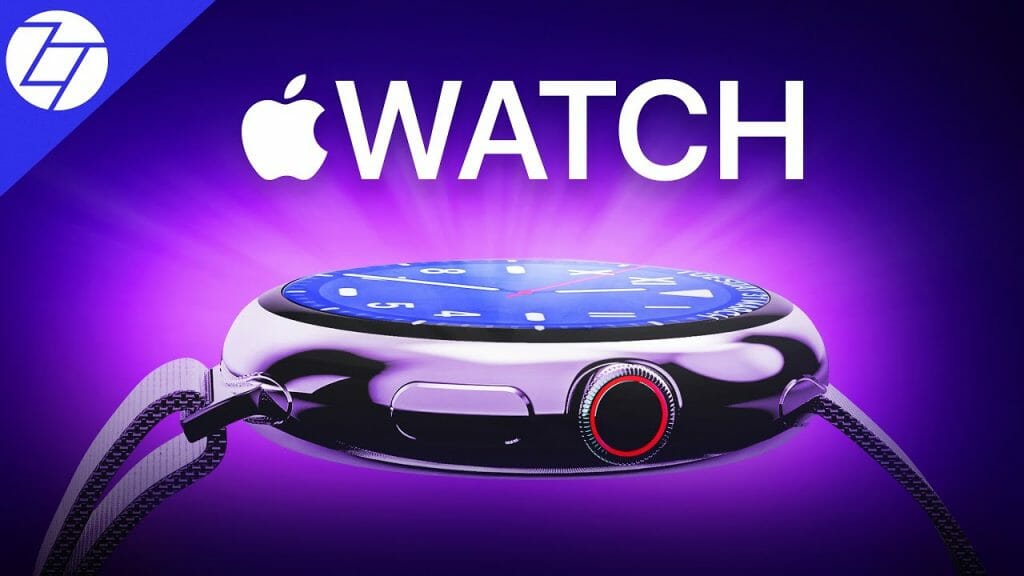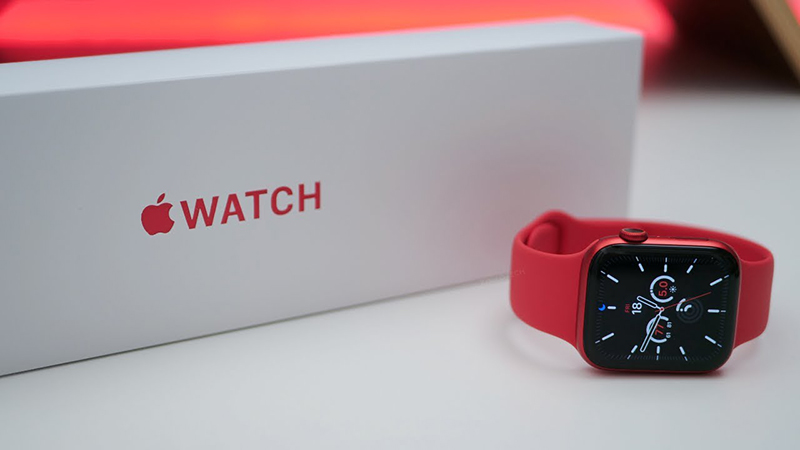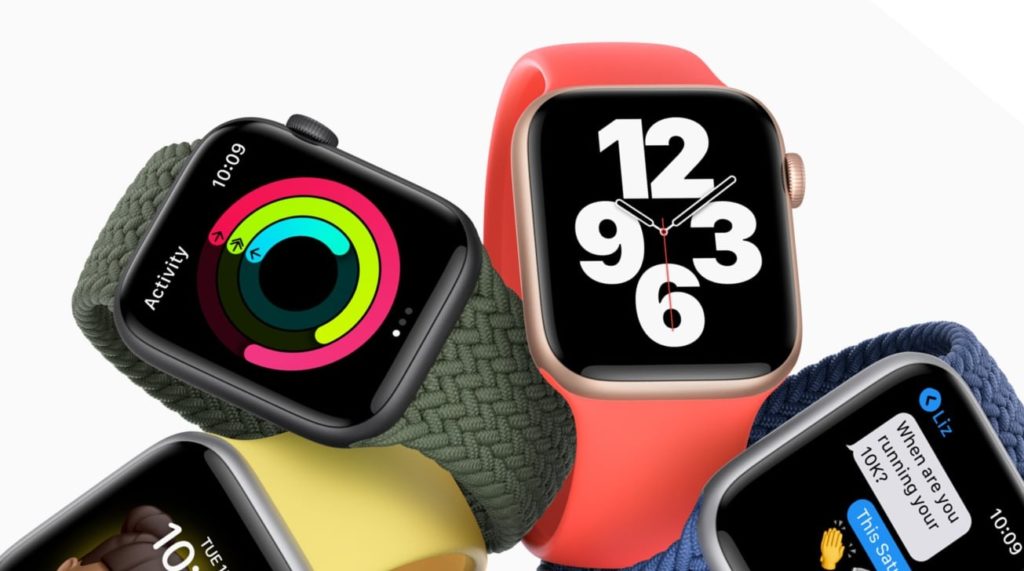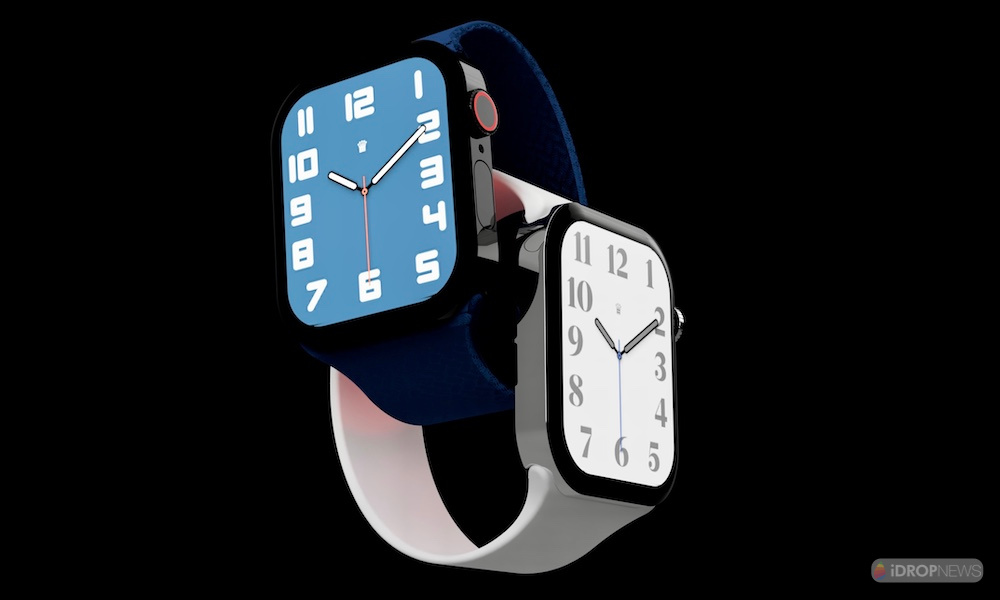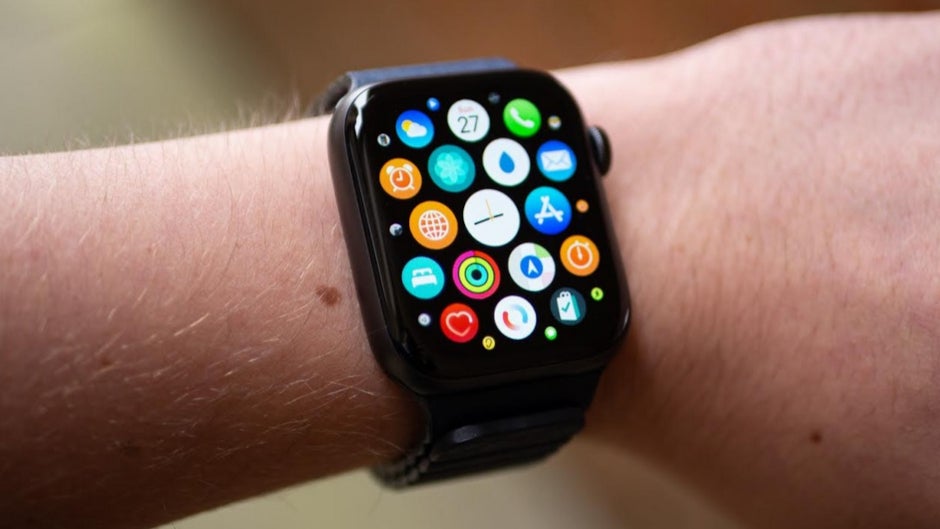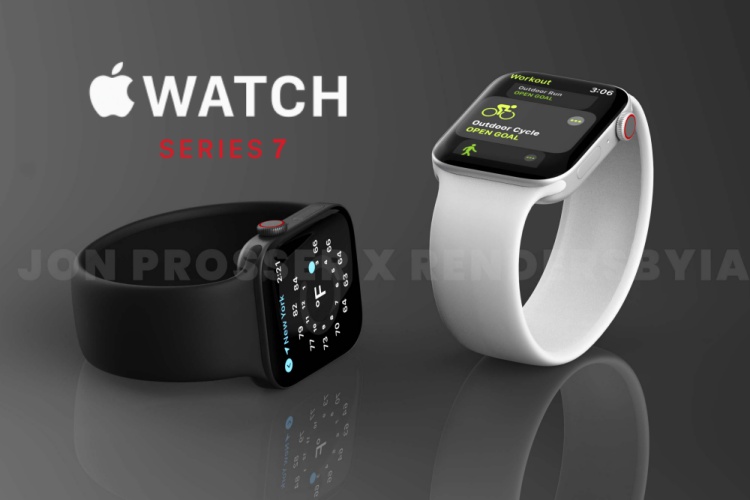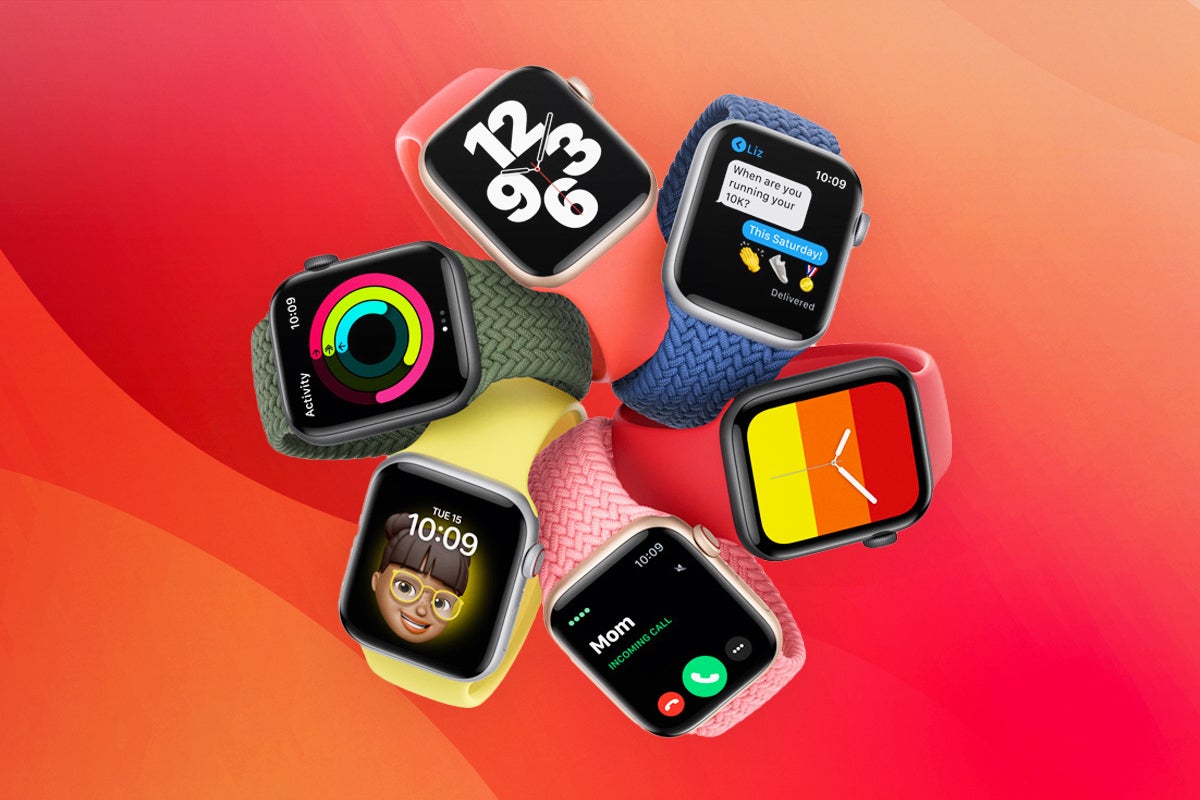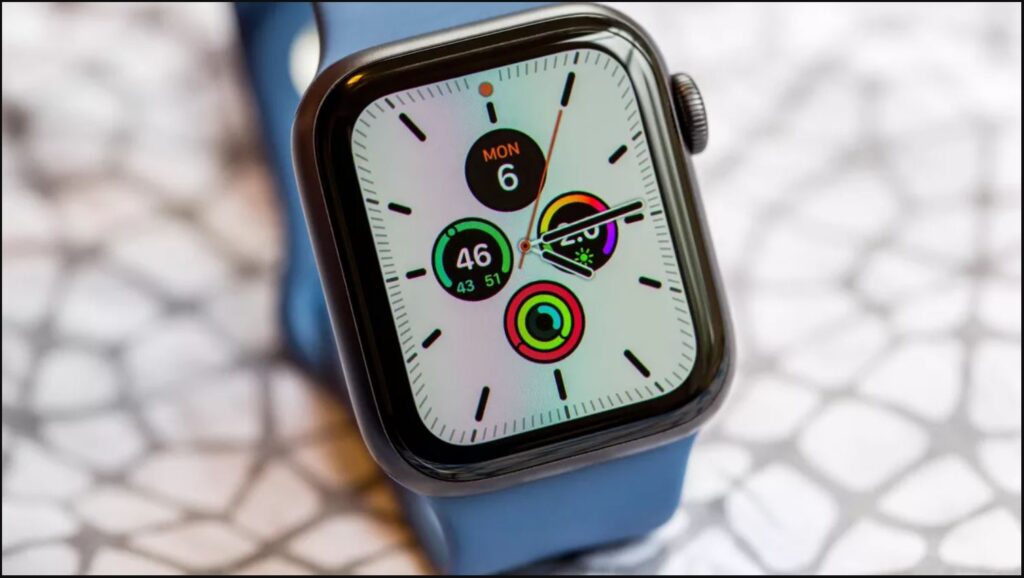The Apple Watch Series 7 offers the same suite of sensors as the Series 6. These include an accelerometer, a gyroscope, a heart rate sensor, a barometer, an always-on altimeter, a compass, an SpO2 sensor, and a VO2 max sensor. These sensors have a host of health and fitness tracking features, including blood oxygen monitoring, heart rate monitoring, sleep tracking, fall detection, workout tracking, and more. Additional features include a new S6 processor that is up to 20% faster than the S4 and S5, a 2.5× brighter always-on display, and an always-on altimeter. The Series 6 watch was updated with faster charging hardware such that it completes charging in ~1.5 hours.
Force Touch hardware was removed, consistent with the removal of all Force Touch functionality from watchOS 7. You may be wondering why this matters, especially if you're looking at your first smartwatch. To understand, we need to explore the best features, mostly related to health and fitness, on the Apple Watch. The Series 7 can recognize if you fall over when working out or off your bike when cycling, and there's fall detection in normal use.
Apple's latest smartwatch is mostly an incremental upgrade from the Apple Watch 6, maintaining an 18-hour battery life, the same CPU and adding no new health features. But the enlarged display is game-changer, and makes it difficult to return to previous-generation models. The Series 7's big screen adapts wearable computing for more everyday applications, making it practical to be productive from your wrist. Apple is a company that builds on yearly iterative improvements, building on features to achieve an even more all-encompassing product, and that is especially the case for the Apple Watch.
With the Series 7, Apple is adding a larger display, improved battery life and energy efficiency, and is elevating the experience of watchOS 8. Using these upgrades, the company is further prepared to launch a redesign of the Apple Watch next year, featuring flat-edges and advanced health sensors. The ECG system has received clearance from the United States Food and Drug Administration, a first ever for a consumer device, and is supported by the American Heart Association. This device can also detect falls and will automatically contact emergency services unless the user cancels the outgoing call.
The microphone was moved to the opposite side between the side button and the digital crown to improve call quality. Other changes include the digital crown incorporating haptic feedback with the Apple Haptic Engine and includes the new Apple-designed W3 wireless chip. At just 1.7 mm thin, the narrower borders of Apple Watch Series 7 maximize the screen area of the display while minimally changing the dimensions of the watch itself.
Apple Watch Series 7 also features a user interface optimized for the larger display, a new QWERTY keyboard, plus two unique watch faces — Contour and Modular Duo — designed specifically for the new device. Users benefit from the same all-day 18-hour battery life,1 now complemented by 33 percent faster charging. Although it has the same design as it's predecessor's, it is equipped with the latest S6 Chip that is 20% faster than its predecessors. Not only is it extremely fast and smooth but it also has a battery life that can last for 18 hours on a single charge. It also comes with various health features like blood oxygen monitoring.
Force touch technology has been removed in Watch Series 6 and Watch SE. The watch also has a side button which can be used to display recently used apps and access Apple Pay, which is used for contactless payment. The watch then reverts to its original mode when recharged or after holding down the side button. Note that the altimeter can be inaccurate in some weather conditions.
The Apple Watch Series 7 offers the same health monitoring features available with the Series 6. A built-in accelerometer and gyroscope enable other important health-related features such as fall detection. Health Features – Other than the blood oxygen monitor and sleep tracking feature, this Apple Watch is equipped with other amazing health features such as ECG monitoring. Apple Watch Series 4, which launched a year later, featured a major redesign with a screen that was 30% bigger in both models and a 50% improvement on its processor over the Series 3 version. Speakers and microphones were rearranged so they were louder and more useful, and Series 4 introduced the fall detection feature, ECG capabilities, and the second-generation heart rate monitor.
The Apple Watch Series 7, announced in September 2021, is the current iteration of the Apple Watch that originally launched in 2015 and replaced the Series 6. The Apple Watch Series 7 builds on the design of previous Apple Watch models with a more rounded design and offers some notable new features including larger displays, improved durability, and faster charging. There are some tradeoffs with the Apple Watch Series 3 because it is a much older model, such as a smaller display, an older chipset, and the lack of a compass, fall detection, ECG, and blood oxygen monitoring.
The increased case sizes were hinted at previously by other sources, but details were scarce at the time. Gurman and YouTube Apple analyst Jon Prosser both also confirmed a new design for the upcoming smartwatch, shifting from curved to flatter edges with thinner bezels and additional colorways. The Series 7 is also equipped with new hardware that enables ultra-rapid, short-range wireless data transfer at 60.5 GHz, though Apple has not fully explained this new functionality. Unlike traditional blood pressure monitoring cuffs, which are usually strapped around the upper arm, it will not provide baseline systolic and diastolic blood pressure measurements. Instead, it will tell you how your blood pressure is trending, the report says.
Samsung has previously incorporated a similar blood pressure feature in this year's Galaxy Watch 4, which is available in some countries and regions like South Korea and Europe, where it has received regulatory approval. Last year, the Series 6 was the most full-featured watch that Apple offered. It had the most complications and the most onboard health-tracking sensors, like optical wrist-based SpO2 measurements and ECGs, all of which I like and found useful.
It also has faster charging times than earlier models, which is a necessity if you want to wear it overnight to track your sleep and charge it in an hour while you shower and eat breakfast before work. Many of its other features are designed to make it a better, and more capable, sports watch. It's more water- and dust-resistant than any previous Apple Watch, and its updated algorithms include better fall detection and more accurate calculation of ebiking fitness metrics. Initial reviews for the device have been generally positive with some caveats. Reviewers praised the watch's potential ability to integrate into everyday life and the overall design of the product, but noted issues of speed and price.
Apple Watch Series 7 Release Date 2021 Malaysia Many reviewers described the watch as functional and convenient, while also noting failure to offer as much potential functionality as preceding smartphones. Farhad Manjoo of The New York Times mentioned the device's steep learning curve, stating it took him "three long, often confusing and frustrating days" to become accustomed to watchOS 1, but loved it thereafter. Some reviewers also compared it to competing products, such as Android Wear devices, and claimed "The Smartwatch Finally Makes Sense".
He concluded that there is no "killer application" so far besides telling the time, which is the basic function of a wristwatch anyhow. TechRadar gave it a score of 4.5/5, calling it one of the top smartwatches, while criticizing the short battery life. Digital Trends gave it a score of 5/5, calling it Apple's best product and praising the design, build quality, and software, among others, while criticizing the battery life. CNET gave it a score of 8.2/10, calling it the "best overall smartwatch around", while criticizing the battery life and lack of watch face options. T3 gave it a score of 5/5, calling it a "truly next-gen smartwatch" due to its thinner body and bigger screen compared to the Series 3, and health features.
In comparison to other Apple products and competing smartwatches, marketing of the Apple Watch promoted the device as a fashion accessory. Apple later focused on its health and fitness-oriented features, in an effort to compete with dedicated activity trackers. The watchOS 3 added fitness tracking for wheelchair users, social sharing in the Activity app, and a Breathe app to facilitate mindfulness. The Series 7 charges 33% faster than its predecessor, thanks to the new magnetic fast-charging USB-C cable. (A charging brick is not included.) It'll get you from 0-80% in about 45 minutes.
Also, if your battery is dead and you'd like to use the watch for sleep tracking, Apple says just eight minutes on the charger gets you enough battery life for eight hours of sleep. Although I'm sure if you asked Apple Watch users, they'd ask for a larger, longer-lasting battery rather than a faster-charging battery. Apple has also made some significant improvements to battery life and charging on the Apple Watch Series 7.
The company claims that the new smartwatches offer 18-hour all-day battery life, along with 33% faster charging than the previous model. After months of leaks and rumors , the Apple Watch Series 7 is finally here. The new smartwatches come with several big upgrades over the previous models, including bigger displays, updated hardware, and more. If you're thinking of getting one for yourself, you've come to the right place. In this post, we'll take an in-depth look at the brand-new Apple Watch Series 7 and tell you everything you need to know to make an informed purchase.
In the past, Apple's watchOS looked similar across all its smartwatches, minus select apps exclusive to the new hardware inside a given model. Apple Watch 7 doesn't have new sensors, though, so instead the company altered watchOS 8 for a bigger screen. Every year sees the release of a new iPhone from Apple, along with a new complementing Apple Watch. This year will see the debut of the iPhone 13 and the Apple Watch Series 7. Bloomberg's Mark Gurman expands upon those rumors by saying that the Series 7 has thinner display bezels than its predecessor.
Speaking of the display, Apple will reportedly use a new lamination process that will make the display appear closer to the display cover (Ion-X or sapphire in the higher-end models). You can anticipate 33 percent faster charging and fall detection during workouts. Most of the updates come through watchOS 8, which now includes detection of cycling workouts, better tracking for e-bikes and help if you fall off. You'll also get a full swipe-based keyboard, support for more workouts and respiratory rate tracking while you sleep.
I was hoping the addition of legitimate sleep tracking would have meant a more aggressive approach to battery life, especially as some of the competition are touting multiple days on a single charge. What we do get, at least, is a new USB-C magnetic charger that is 33% faster than the one on the Series 6, giving you an 80% charge in around 45 minutes. What that means in practical terms is a full night's charge in less than 10 minutes.
So if you're strategic about charging, you can effectively wear it day and night. Apple Watch Series 7 features a refreshed design and a larger display in both models, but no new processor or health sensors. There's a mystery surrounding this year's Apple Watch, as many rumors pointed to it having a new flat design that ended up not happening. But the most compelling draw of the Apple Watch 7 are the added health and fitness features it offers, including high-end, accurate blood pressure, glucose, blood oxygen, and alcohol level monitoring capabilities.
The debut of the Apple Watch 7 is approaching, and despite the scant leaks about the next wristwatch, we have a fair sense of what to anticipate. The Apple Watch 7, as a follow-up to the Apple Watch Series 6, should have a slew of improvements that make the finest wristwatch even better. We might see a new health sensor, a better display, and longer battery life, among other things. WatchOS 3.0 was announced at WWDC 2016, with a priority on performance. Users are able to keep apps running in memory as well as receive background updates and refreshed information. Other updates include a new Dock invoked with the side button to replace the performance-laden Glances, an updated Control Center, and new reply options on Messages.
Several new watch faces have also been added, including Minnie Mouse, along with the ability to switch watch faces from the lock screen simply by swiping. A new app called Breathe guides users through breathing exercises throughout the day, with visuals and haptic feedback. The 1st generation Apple Watch uses the single-core S1 system-on-chip. It does not have a built-in GPS chip, instead relying on a paired iPhone for location services.
It uses a linear actuator called the "Taptic Engine" to provide haptic feedback when an alert or a notification is received, and is used for other purposes by certain apps. The watch is equipped with a built-in heart rate sensor, which uses both infrared and visible-light LEDs and photodiodes. All versions of the first-generation Apple Watch have 8 GB of storage; the operating system allows the user to store up to 2 GB of music and 75 MB of photos.
When the Apple Watch is paired with an iPhone, all music on that iPhone is also available to be controlled and accessed from the Apple Watch. There is a rumor floating around that the Series 7 could be the first Apple Watch with a 120Hz refresh rate. Apple is expected to bring this high refresh rate display to the upcoming iPhone 13, which has obvious advantages for a smartphone , but it's a little less clear how it would drastically improve the smartwatch experience. Maybe Apple will make it an optional feature that you can toggle on/off, because the 120Hz refresh rate could take a big hit on the Series 7's battery life. This watch face will show 24 time zones simultaneously on the display.
Reportedly, Apple is working on some others watch faces that will be exclusively available in Series 7. The new smartwatch will have an S7 cheap that will provide a better battery life. And according to Ming-Chi Kuo, many health sensors will be missing in the latest release. In fact, they have a plan to re-introduce them in the 2022 Apple Watch series.
Fitness aspects are unchanged with the same workout tracking, heart rate detection, and awards as previous models. Users can take an ECG, notify emergency contacts in the event of a fall, and get abnormal heart rate notifications as well. The Apple Watch Series 6 is already one of the most comprehensive smartwatches when it comes to health and fitness tracking. While we wouldn't expect the Series 7 deliver too many major tracking mode advancements, the current iteration does feature fairly rudimentary sleep stats – something we'd hope to see updated. According to Bloomberg's seasoned tech reporter Mark Gurman, however, we shouldn't hold our breath for these new health features to arrive on the upcoming Apple Watch. This Watch brought a new S6 processor, up to 20% faster than its predecessor, a brighter Always-On display, a blood oxygen app, and an always-on altimeter, alongside new health sensors.
But the smartwatch still has an impressive array of health monitoring features to track ECG, blood oxygen levels, heart rate, and plenty of other metrics. When using the Apple Watch, some users have reported issues using the heart monitoring feature due to permanent skin conditions including tattoos. The Watch uses photoplethysmography technology which utilizes the green LED lights to measure heart rates. To gauge a user's heart rate, the watch flashes green light from the LEDs at the skin and records the amount of this light that is absorbed by the red pigment of the blood. However, under certain circumstances the skin may not allow for the light absorption to be read properly and thus provide inaccurate results.
Even in late 2021, that's a fair price to pay for the company's budget-friendly smartwatch. It has many of the same features as the Series 6 and 7 but lacks ECG and SpO2 sensors, which the average user might not care about anyway. For some reason, the Apple Watch Series 3 is also still widely available across the internet. The next-generation Apple Watch is rumored, according to The Telegraph, to be able to track your blood glucose levels, your blood pressure and your blood alcohol levels. Its new sensor could shine infrared light through your skin to take these measurements, which is the same kind of sensor used by the Series 6 to take your blood oxygen levels and heart rate. WatchOS 8 comes with additional watch faces specifically designed to fit the Apple Watch Series 7 bigger display.
And of course, what is an Apple Watch without its health and wellness features? The watch comes with a new Mindfulness app, and with the important for your health monitoring sleep respiratory rate tracking. In terms of workouts, some new workout types such as Tai Chi and Pilates are also added. Apple's next major sensor addition to the Apple Watch may not happen anytime soon, with rumored features such as glucose monitoring and blood pressure tracking potentially years away from launch.
